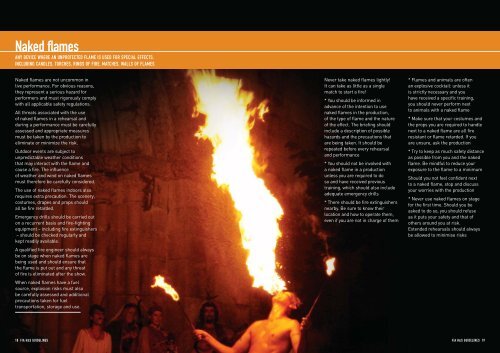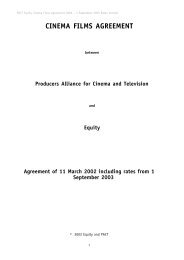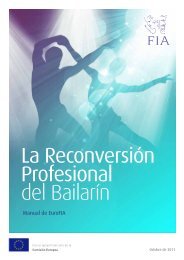ACTSAFE
landscape version - the International Federation of Actors
landscape version - the International Federation of Actors
- No tags were found...
Create successful ePaper yourself
Turn your PDF publications into a flip-book with our unique Google optimized e-Paper software.
Naked flames<br />
ANY DEVICE WHERE AN UNPROTECTED FLAME IS USED FOR SPECIAL EFFECTS,<br />
INCLUDING CANDLES, TORCHES, RINGS OF FIRE, MATCHES, WALLS OF FLAMES<br />
Naked flames are not uncommon in<br />
live performance. For obvious reasons,<br />
they represent a serious hazard for<br />
performers and must rigorously comply<br />
with all applicable safety regulations.<br />
All threats associated with the use<br />
of naked flames in a rehearsal and<br />
during a performance must be carefully<br />
assessed and appropriate measures<br />
must be taken by the production to<br />
eliminate or minimize the risk.<br />
Outdoor events are subject to<br />
unpredictable weather conditions<br />
that may interact with the flame and<br />
cause a fire. The influence<br />
of weather and wind on naked flames<br />
must therefore be carefully considered.<br />
The use of naked flames indoors also<br />
requires extra precaution. The scenery,<br />
costumes, drapes and props should<br />
all be fire retarded.<br />
Emergency drills should be carried out<br />
on a recurrent basis and fire-fighting<br />
equipment – including fire extinguishers<br />
– should be checked regularly and<br />
kept readily available.<br />
A qualified fire engineer should always<br />
be on stage when naked flames are<br />
being used and should ensure that<br />
the flame is put out and any threat<br />
of fire is eliminated after the show.<br />
When naked flames have a fuel<br />
source, explosion risks must also<br />
be carefully assessed and additional<br />
precautions taken for fuel<br />
transportation, storage and use.<br />
Never take naked flames lightly!<br />
It can take as little as a single<br />
match to start a fire!<br />
* You should be informed in<br />
advance of the intention to use<br />
naked flames in the production,<br />
of the type of flame and the nature<br />
of the effect. The briefing should<br />
include a description of possible<br />
hazards and the precautions that<br />
are being taken. It should be<br />
repeated before every rehearsal<br />
and performance<br />
* You should not be involved with<br />
a naked flame in a production<br />
unless you are required to do<br />
so and have received previous<br />
training, which should also include<br />
adequate emergency drills<br />
* There should be fire extinguishers<br />
nearby. Be sure to know their<br />
location and how to operate them,<br />
even if you are not in charge of them<br />
* Flames and animals are often<br />
an explosive cocktail: unless it<br />
is strictly necessary and you<br />
have received a specific training,<br />
you should never perform next<br />
to animals with a naked flame<br />
* Make sure that your costumes and<br />
the props you are required to handle<br />
next to a naked flame are all fire<br />
resistant or flame retarded. If you<br />
are unsure, ask the production<br />
* Try to keep as much safety distance<br />
as possible from you and the naked<br />
flame. Be mindful to reduce your<br />
exposure to the flame to a minimum<br />
Should you not feel confident next<br />
to a naked flame, stop and discuss<br />
your worries with the production<br />
* Never use naked flames on stage<br />
for the first time. Should you be<br />
asked to do so, you should refuse<br />
as it puts your safety and that of<br />
others around you at risk.<br />
Extended rehearsals should always<br />
be allowed to minimise risks<br />
18 FIA H&S GUIDELINES FIA H&S GUIDELINES 19







